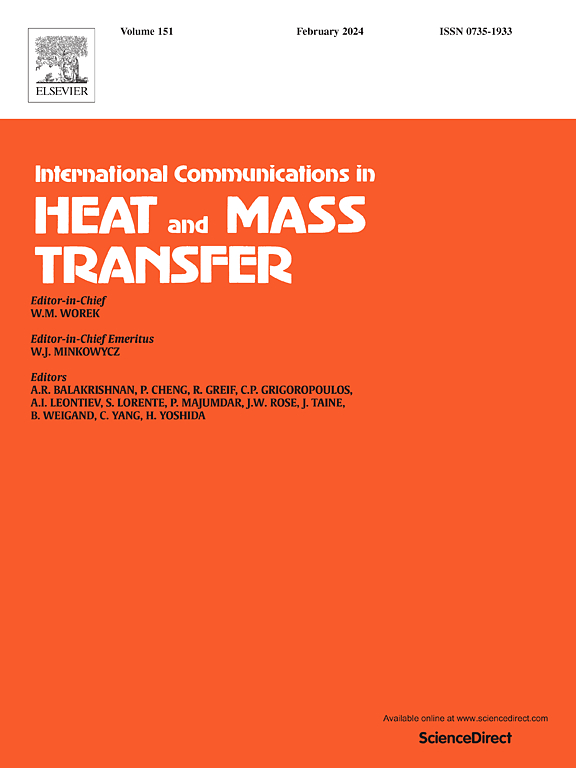Study of ionic water/graphene nanofluids in solar panels under the effects of thermal radiation and slip conditions using experimental data
IF 6.4
2区 工程技术
Q1 MECHANICS
International Communications in Heat and Mass Transfer
Pub Date : 2025-03-24
DOI:10.1016/j.icheatmasstransfer.2025.108845
引用次数: 0
Abstract
The combination of the extensive surface area and thermal conductivity of graphene oxide (GO) with the thermal stability and low volatility of ionic liquid (IL) enhances thermal energy efficiency in solar collectors. This study theoretically examined the flow characteristics of various nanofluids in a solar collector, specifically ionic liquid/GO, a mixture of 75% ionic liquid and 25% water (HO)/GO, a 50% ionic liquid and 50% water/GO blend, and water/GO. To accurately assess the effects of buoyancy, solar radiation, nanoparticle absorption, and the overall thermal energy transfer from the boundary to the collector, this study incorporates nonlinear free convection, nonlinear thermal radiation, heat absorption, and slip and jump phenomena under convective conditions. The mathematical model was developed using non-similarity variables, and the results were obtained using the Garlakin weighted residual method (GWRM). This study demonstrates that an increase in the nonlinear free convective parameter, nonlinear thermal radiation, and heat absorption enhances the thermal energy of the nanofluid within the collector. The pure ionic liquid combined with graphene oxide (IL/GO) nanofluid demonstrated a thermal energy efficiency that exceeded that of water by 36.8%, which quantitatively corroborated the experimental result of 37.4%. This indicates that increased IL/GO nanofluid concentrations are optimal for high-intensity solar applications, whereas water is preferable for moderate solar conditions to prevent overheating.
求助全文
约1分钟内获得全文
求助全文
来源期刊
CiteScore
11.00
自引率
10.00%
发文量
648
审稿时长
32 days
期刊介绍:
International Communications in Heat and Mass Transfer serves as a world forum for the rapid dissemination of new ideas, new measurement techniques, preliminary findings of ongoing investigations, discussions, and criticisms in the field of heat and mass transfer. Two types of manuscript will be considered for publication: communications (short reports of new work or discussions of work which has already been published) and summaries (abstracts of reports, theses or manuscripts which are too long for publication in full). Together with its companion publication, International Journal of Heat and Mass Transfer, with which it shares the same Board of Editors, this journal is read by research workers and engineers throughout the world.

 求助内容:
求助内容: 应助结果提醒方式:
应助结果提醒方式:


